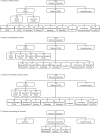Prevalence of Polycystic Ovary Syndrome Phenotypes Using Updated Criteria for Polycystic Ovarian Morphology: An Assessment of Over 100 Consecutive Women Self-reporting Features of Polycystic Ovary Syndrome
- PMID: 24520081
- PMCID: PMC4126218
- DOI: 10.1177/1933719114522525
Prevalence of Polycystic Ovary Syndrome Phenotypes Using Updated Criteria for Polycystic Ovarian Morphology: An Assessment of Over 100 Consecutive Women Self-reporting Features of Polycystic Ovary Syndrome
Abstract
The prevalence of polycystic ovary syndrome (PCOS) and its distinct clinical phenotypes were assessed using 3 sets of international diagnostic criteria in women self-reporting concerns over outward features of PCOS. Revised ultrasonographic criteria for polycystic ovaries (PCO) based on modern ultrasound technology were used. Of the participants, 53%, 62%, and 70% were diagnosed with PCOS using National Institutes of Health, Androgen Excess and PCOS Society, and Rotterdam criteria, respectively. Prevalence of Frank, Ovulatory, Normoandrogenic, and Non-PCO PCOS were 66%, 13%, 11%, and 9%, respectively. Frank PCOS was associated with the severest metabolic disturbances whereas metabolic profiles in Normoandrogenic PCOS did not differ from controls, supporting reduced health risks in women without androgen excess. Metabolic disturbances and hyperandrogenism were linked to excess adiposity across all the groups. Using updated criteria for PCO, the prevalence of Non-PCO PCOS and PCO alone in healthy women recruited from the general population was reduced compared to the previous reports.
Keywords: hirsutism; hyperandrogenism; phenotypes; polycystic ovary syndrome; ultrasonography.
© The Author(s) 2014.
Conflict of interest statement
Figures

References
-
- Stein IF, Leventhal ML. Amenorrhea associated with bilateral polycystic ovaries. Am J Obstet Gynecol. 1935;29:181–191
-
- Azziz R. Diagnosis of polycystic ovarian syndrome: the Rotterdam criteria are premature. J Clin Endocrinol Metab. 2006;91(3):781–785 - PubMed
-
- Zawadzki JK, Dunaif A. Diagnostic Criteria for Polycystic Ovary Syndrome: Towards a Rational Approach. Boston: Blackwell Scientific Publications; 1992
-
- Rotterdam ESHRE/ASRM-Sponsored PCOS Consensus Workshop Group. Revised 2003 consensus on diagnostic criteria and long-term health risks related to polycystic ovary syndrome (PCOS). Fertil Steril. 2004;81(1):19–25 - PubMed
LinkOut - more resources
Full Text Sources
Other Literature Sources

